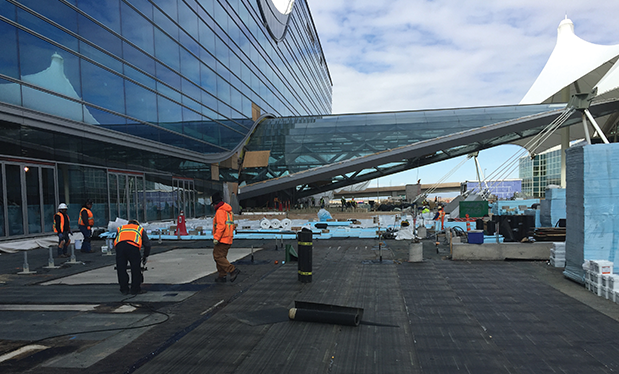In April, The American Institute of Architects (AIA) issued new editions of its standard construction contract documents, including AIA A201 General Conditions. AIA construction contracts are the most widely used contracts in the construction industry and frequently serve as templates even when an AIA-drafted document is not used.
In addition to A201-2017 General Conditions, AIA revised its Owner-Contractor agreement forms (A101, A102, A103, A104 and A105), Owner-Architect agreement forms (B101, B103, B104 and B105), Contractor-Subcontractor agreement (A401) and Architect-Consultant agreement (C401).
Since 1997, AIA has published new editions of its contract documents every 10 years. The 2017 editions of the AIA contracts will succeed the 2007 versions.
The most significant and visible change in the 2017 documents is a change in format to give more prominence to insurance and provide more detail regarding insurance coverages through the use of a seven-page Insurance and Bonds Exhibit. The new exhibit will cause the parties to give more consideration to insurance at the outset of a construction project and ensure policies do not exclude coverages that might otherwise be limited by exclusions some insurers have included in their policies.
Each of the 2017 Owner-Contractor Agreements (A101, A102 and A103) include the new Insurance and Bonds Exhibit, describing the insurance an owner and contractor are required to maintain and naming optional insurance coverages that might be obtained. The exhibit includes listing numerous options pertaining to additional insurance coverages the parties may require by filling in boxes as well as exclusions to commercial general liability (CGL) policies that are prohibited.
AIA has long believed insurance is a primary mechanism that should be used to manage risks associated with construction projects, and the 2017 edition of the AIA contract documents makes reliance on insurance more prominent. The inclusion of a standard AIA exhibit that will be part of AIA construction contracts will cause owners and other parties to give more attention and consideration to insurance coverages that are to be in place before a job starts, endorsements and exclusions, and who is responsible to obtain each policy. Before the 2017 edition of the AIA documents, insurance requirements were buried in the standard text of Article 11 of the AIA A201 General Conditions and frequently parties were not fully aware of what was required until a claim arose.
Property insurance
The 2017 AIA Insurance and Bonds Exhibit expands the property insurance provisions from earlier editions of A201 General Conditions. The owner still is required to purchase and maintain property insurance written on a builder's risk "all-risks" completed value or equivalent policy form and sufficient to cover the total value of the construction project on a replacement-cost basis. The all-risks property insurance must provide coverage for direct physical loss or damage and cover the risks of fire, explosion, theft, vandalism, malicious mischief, collapse, earthquake, flood and windstorm. An owner also now is responsible for losses not covered because of deductibles or self-insured retentions. The insurance exhibit entitles the contractor to request and obtain a copy of the property insurance policy from the owner.
Per Article 11 of all editions of A201 General Conditions, if an owner does not intend to purchase the required property insurance, he or she is to inform the contractor in writing before the job starts. The contractor then can procure builder's risk insurance and the cost will be added by change order to the contract. If the owner fails to obtain the insurance and notify the contractor in writing, the owner is responsible for any losses that would otherwise be covered by the insurance.
In addition, all A201 editions include a broad waiver of subrogation applicable to losses covered under the required property insurance. The contract states the owner and contractor waive all rights against each other and their subcontractors, sub-subcontractors, the architect, and their agents and employees for damages caused by fire or other causes of loss. The waiver applies to the extent the losses are covered by the required property insurance or other applicable insurance except those rights they have to the insurance proceeds.
The insurance policies maintained by the parties should not include a provision prohibiting a waiver of subrogation rights. The property damage waiver in AIA A201 is broader than a waiver of subrogation because it waives the parties' rights in addition to the insurer's subrogation rights. The waiver is to apply even if a party had a contractual or other indemnification obligation to another party and the party benefiting from the waiver did not pay the insurance premium.
To envision how these provisions apply, suppose a fire started on a roof during construction of a new building. With the AIA A201 property insurance provisions in effect, the builder's risk property insurance policy the owner is required to maintain would pay for the damages to the roof and other parts of the building under construction and neither the builder's risk insurer nor other parties could pursue a claim against another party whom they thought was responsible for causing the fire.
The 2017 AIA insurance exhibit expands the scope of the required property insurance in a manner that can be significant and helpful to roofing contractors performing reroofing work and other contractors engaged in remodeling and rehabilitating existing buildings.
Article A.2.3.3, Insurance for Existing Structures, of the 2017 AIA insurance exhibit states if work involves remodeling an existing structure or constructing an addition to an existing structure, the owner is to purchase and maintain all-risks property insurance on a replacement cost basis, protecting the existing structure against direct physical loss or damage from fire, explosion, theft, vandalism, malicious mischief, collapse, earthquake, flood and windstorm.
Before the 2017 AIA documents were issued, court decisions regarding whether the AIA waiver of subrogation applied to damage to an existing building were mixed. Some courts ruled the waiver of subrogation applied only to the work of the contractor so damage to an existing building a contractor was reroofing was not encompassed by the waiver and the contractor could be sued. Other courts, interpreting the pre-2017 A201, held if the owner's property insurance that included builder's risk coverage also covered the existing building, the waiver of subrogation applied to all property damage covered by the property damage policy.
Article A.2.3.3 of the 2017 exhibit eliminates this uncertainty by expressly stating the AIA-required all-risks property insurance is to include damage to the existing building. With this provision in effect, a party who relies on a traditional builder's risk policy to meet the AIA property insurance requirement will need to make sure the policy includes an existing structures endorsement. Alternatively, the owner can use a property insurance policy that covers the existing building and builder's risk insurance covering the remodeling or addition to the building.
Article A.2.3.3 of the 2017 AIA insurance exhibit also expands the time period the required all-risks property insurance must be in effect. The 2007 edition of AIA A201 stated the required property insurance was to be maintained (unless otherwise agreed by all parties) until final payment was made or no party other than the owner had an insurable interest in the property. The 2017 exhibit requires the owner to maintain the insurance until the period during which the contractor is to correct any work not in accordance with the contract documents, typically one year after substantial completion of the work.
Typical builder's risk policies apply until final acceptance of the work by the owner; additional coverage will need to be obtained to satisfy the AIA requirement that builder's risk insurance remain in effect after completion.
Going beyond the language in the 2007 and earlier editions, the 2017 insurance exhibit states builder's risk property insurance "shall also provide coverage for ensuing loss or resulting damage from error, omission, or deficiency in construction methods, design, specifications, workmanship or materials." The meaning of this language likely will be the source of future litigation just as the meaning of the "ensuing loss exception" is the source of coverage disputes in property insurance policies.
Because an owner's obligation to purchase and maintain all-risks property insurance historically was found in Article 11 of the AIA A201 General Conditions, some owners were unaware of their obligation to purchase the insurance and the waiver of subrogation, particularly when undertaking reroofing and remodeling projects, until a loss occurred. With the use of the new insurance exhibit, contractors may be called upon more often to obtain the required builder's risk property insurance.
The provision stating the owner is to purchase the builder's risk insurance begins "[u]nless this obligation is placed on the Contractor" and goes on to include a box that, if marked, requires the contractor to purchase the required builder's risk insurance. The contractor will need to be sure the policy he or she obtains includes the existing structure and extends for the period the contractor is required to correct deficiencies or alter the contract language in the AIA insurance exhibit. It may be difficult for contractors to obtain expanded builder's risk coverage that meets the 2017 AIA requirements.
Pollution and CGL insurance
Unlike earlier editions of A201, the 2017 insurance exhibit requires contractors to procure pollution insurance coverage if the work involves the transport, dissemination, use or release of pollutants. The pollution policy limits are to be inserted by the parties. If a contractor is required to provide professional services as part of the work, he or she will need to procure professional liability insurance. Again, the policy limits are to be inserted into the insurance exhibit.
Regarding CGL insurance, the exhibit prohibits certain exclusions and limitations that sometimes are included in CGL policies.
For example, CGL policies exclude damage to an insured contractor's work, including the cost to repair or replace work that is alleged to be defective, known as the "your work" exclusion. The 1986 edition of the standard CGL policy issued by the Insurance Services Office added a subcontractor exception to the "your work" exclusion, which provides insurance coverage to a general contractor when a subcontractor's allegedly defective workmanship damages work performed by another subcontractor or the general contractor.
In the absence of the exception, a general contractor might have no insurance coverage for damage to a new construction project resulting from defective work performed by a subcontractor because the exclusion covers work performed by or on behalf of the named insured. The same treatment applies when a subcontractor retains a sub-subcontractor. In recent years, some insurers have deleted the exception, but the 2017 AIA insurance exhibit prohibits such deletions.
The exhibit also prohibits exclusions from the contractor's CGL policy for the following:
- Claims by one insured against another insured
- Claims for bodily injury other than to employees of the insured
- Claims for indemnity arising out of injury to the insured's employees
- Claims or loss excluded under an earlier endorsement
- Claims relating to residential or other habitational projects if the work is to be performed on such a project
- Claims relating to roofing if the work involves roofing
- Claims relating to exterior insulation finish systems, synthetic stucco or similar exterior coatings or surfaces if the work involves such coatings or surfaces
- Claims relating to earth subsidence or movement where the work involves such hazards
- Claims relating to explosion, collapse and underground hazards where the work involves such hazards
Other changes
Other than the insurance exhibit, perhaps the most significant change in the 2017 AIA contract documents affecting contractors is a new requirement that notice of claims must be made by certified or registered mail or by courier providing proof of delivery. Claims arising during construction and during the year after construction when the contractor contractually is required to make corrections must be submitted to the architect before proceeding with arbitration or litigation. Contractors who fail to follow these contract requirements may find their claims will not be considered on the merits.
Per the A201 General Conditions, a claim is defined as "a demand or assertion by one of the parties seeking, as a matter of right, payment of money, or other relief with respect to the terms of the Contract." A201 General Conditions require claims for additional cost and time must be initiated by written notice to the other party and the Initial Decision Maker with a copy sent to the architect if the architect is not serving as the Initial Decision Maker within 21 days after occurrence of the event or within 21 days after the claimant first recognizes the condition giving rise to the claim, whichever is later.
A201-2017 clarifies claims arising after completion and expiration of a contractor's correction period can proceed directly to arbitration or litigation depending on which contract dispute procedure the parties have designated in the contract.
For a claim based on differing site conditions, A201-2017 reduces the maximum time period within which a contractor is required to notify the owner and architect from 21 to 14 days.
Another change focuses on the imposition of liquidated damages for delays in construction. A specific area has been added to the owner-contractor agreements to prompt the parties to consider imposing liquidated damages with the amount and details to be negotiated by the parties and inserted into the contract. An area also has been added if the parties desire to add a bonus or incentive provision for early completion or other incentives.
The 2017 AIA exhibit now also includes a provision stating the contractor is to provide surety bonds. The provision indicates the type and penal sum of bonds is to be inserted, but the exhibit lists payment and performance bonds and states the payment and performance bonds shall be AIA Document A312, Payment Bond and Performance Bond, or contain provisions identical to the current edition of AIA Document A312. This provision would appear to require the contractor to obtain performance and payment bonds whenever the AIA Insurance and Bonds Exhibit is used unless the parties expressly indicate no bonds are required.
The AIA A312 payment and performance bonds contain time limitations (one year for payment bonds and two years for performance bonds) to file suit under the bond and are less onerous than bond forms typically promulgated by general contractors to be executed by subcontractors. Article 11 of the current and prior editions of A201 require the contractor to promptly furnish a copy of the payment bond upon the request of any person or entity who appears to be a potential beneficiary of the bond. In other words, subcontractors, sub-subcontractors and material suppliers can obtain copies of payment bonds issued by the contractor and his or her surety.
A provision requiring more detailed information regarding the construction schedule also has been added to A201-2017. The new provision requires a contractor to submit a construction schedule that includes the date of commencement of work, interim milestone dates, the date of substantial completion, an apportionment of the work by construction activity, and the time required for completion of each portion of the work.
And a new provision has been added to A201-2017 recognizing a change to a contractor's schedule of values may be appropriate during construction.
For the first time, the 2007 edition of the AIA contracts gave owners the right to terminate a contract for an owner's convenience so that even if there had been no default or inadequate performance by the contractor, the owner could terminate the contract. However, if the owner invoked this provision, the contractor still was entitled to receive reasonable overhead and profit on work not performed in addition to payment for work performed and costs incurred because of the termination. A201-2017 eliminates a contractor's right to receive reasonable overhead and profit on unexecuted work; instead, a stipulated termination fee would be negotiated and inserted into the contract by the parties.
The provisions in the owner-contractor agreement regarding dates of commencement and substantial completion have been revised to require the parties to be more specific, facilitating the imposition of liquidated damages. The parties are to check a box indicating whether the date of commencement is to be the date of the contract, the date of issuance of a notice to proceed or a different date. Similarly, check boxes have been added for the parties to indicate whether substantial completion will be achieved no later than a specified calendar date or a certain number of days from the date of commencement, and a separate section has been added to insert the completion dates of certain phases of the work.
AIA's provision that state law governing a project is the law of the state where the project is located has been strengthened by adding a provision stating the law of the state where a project is located shall apply even if that state's law allows another state's law to apply.
And finally, a provision has been added to A201-2017 requiring contractors to defend and bond off mechanic's liens by subcontractors and material suppliers if the owner has met its payment obligations.
Wrapping up
First issued in 1888, the standard AIA contract documents continue to provide a comprehensive, reasonable set of contract terms and conditions to govern construction projects. Later this year and in the years ahead, contractors will see the 2017 edition of AIA's standard contract documents instead of the 2007 edition.
The primary change ensuing from the 2017 edition of the AIA's contract documents for bid-design-build contracts will be a more rigorous, comprehensive consideration of insurance coverages. More than ever, contractors will need to retain qualified risk and insurance advisers and brokers who are familiar with AIA's new insurance exhibit, specific requirements designated in the contract, and exact coverages and exclusions contained in a contractor's existing policies. Contractors should obtain guidance from their insurance advisers before executing contracts to be sure they satisfy contractual insurance requirements.
Stephen M. Phillips is a senior partner with Atlanta-based law firm Hendrick, Phillips, Salzman & Siegel.



